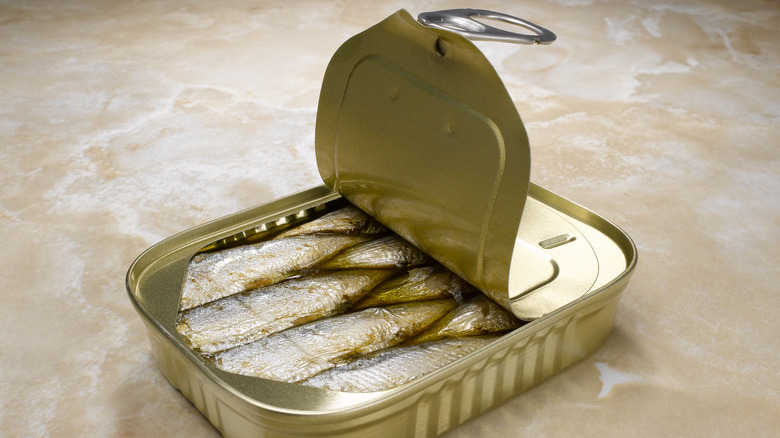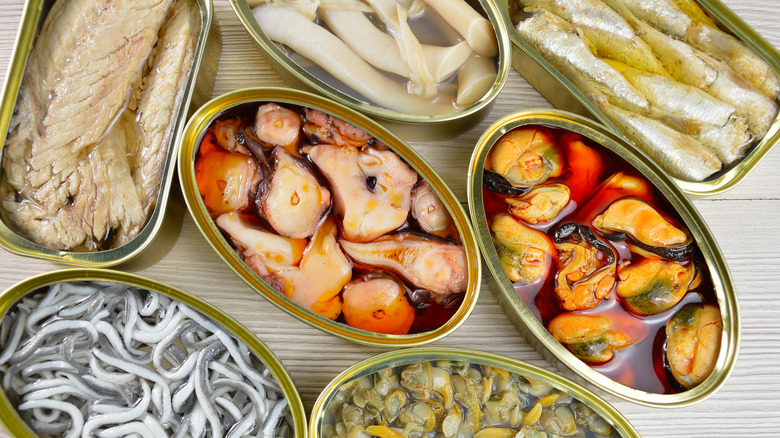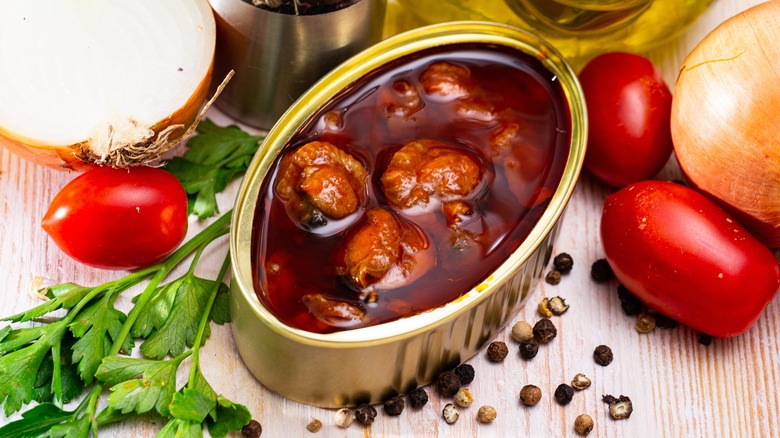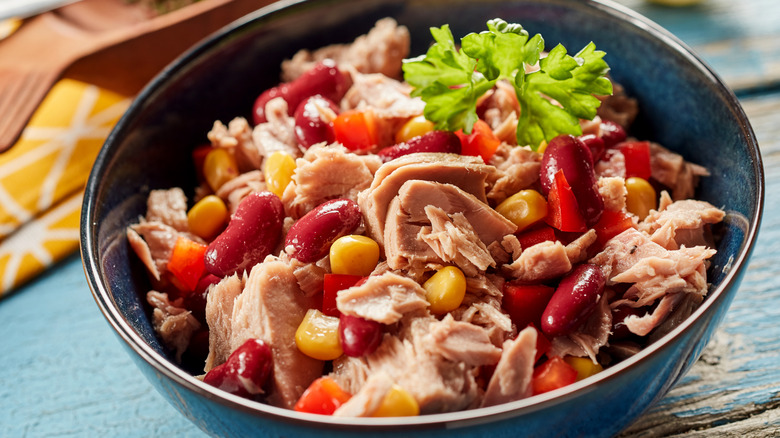13 Facts About Tinned Fish Andrew Zimmern Wants You To Know
Whether it's a quick and tasty snack or part of a more elaborate meal, tinned fish is an underrated food you should probably keep stocked in your pantry. When Europeans discovered how to sterilize meat and pack it in tin cans effectively, tinned seafood was heralded as a safe and convenient way for soldiers and travelers to obtain nutrition while away from home. Canned fish is still a great option for those seeking convenient protein on the road, but it's also a good option for the everyday home cook.
There are some things you should know about tinned fish, though, and we consulted with Andrew Zimmern, passionate fisherman, chef, and lover of tinned fish, to gather the facts about the various types of canned seafood available. Host of Outdoor Channel's "Field to Fire," Zimmern catches his own food before creating his masterpieces over an outdoor fire. But there are times when fresh-caught fish isn't an option and the quick convenience of canned fish is a practical decision. Even Zimmern relies on imported tinned fish — favoring those from Portugal — for a salad topping or quick meal when he's been busy working. We interviewed Zimmern to find out more about what makes tinned fish so special.
1. Tinned fish is a convenient preservation method for seafood
Preserving food has long been a necessity for storing perishable eats for extended periods. Canning is one of the best and most convenient ways to preserve just about all types of food. Before cold or frozen storage came along, salting, smoking, and dehydrating were also common methods to keep food edible for indefinite amounts of time. These days, most folks use a refrigerator or freezer, but your pantry or basement is still a valid place to store properly sealed food.
Europeans may have been the first to perfect canned seafood, but it's widely available worldwide (although it isn't quite as popular here in the U.S.) There are times when convenience wins out, though, in the great food debate of fresh versus canned nutrition and we reach for a can of tuna or sardines. "Preservation and convenience go hand in hand," says Andrew Zimmern, "and in [other] countries, there is no perceived bias because a seafood item is tinned." Some tinned fish companies also offer a whole, prepared dish in one tin, Zimmern says, such as oysters in escabeche, or sardines in mustard sauce, making it even more convenient to have delicious nutrition on hand.
2. Fatty fish tins well
"If you can catch it, you can tin it," Andrew Zimmern tells us. This is why you can find such a wide range of canned fish brands on the shelves at your local grocery stores or offered online. But it's not as easy as just picking up any old brand off the shelf. You should be discerning about what you're looking for. Within the conservas family — which refers to the culinary world of tinned or jarred seafood — there's a spectrum of low-end to high-quality products.
Zimmern tells us, "Fatty fish like tuna, mackerel, sardines, [and] anchovies do well [tinned]; same with fatty shellfish like oysters or mussels." Fish that feature a fattier nature preserves better than leaner fish. Lean fish tends to dry out during the process, while a fattier fish maintains its moisture. Indeed, tuna, sardines, and oysters are the kinds of seafood you most often see available in cans. And if you're new to tinned fish, we'd recommend starting with one of Zimmern's suggested options.
3. Seafood tinned whole or as fillets is optimal
If your only foray into canned fish cuisine comes from a can of tuna found in the discount bin at your local bargain store, you're probably used to a tin full of packed, flaked fish that's as far from its original form as it gets. This is not the type of tinned fish we're talking about (but if you have a few budget cans of tuna in your pantry, here's what you can do with them.) Andrew Zimmern recommends finding tinned fish that's offered in whole (whether fin or shellfish) or fillet form. But just like all seafood, he says, try various canned fish brands to find the type you like.
Whole fish or fillets allow you to enjoy tinned seafood as close to its freshly cooked version as possible. You may be familiar with sardines being tinned whole, with skin on (maybe the head, too) and bones included. Keeping the fish whole helps maintain its initial quality. Since seafood is cooked during the canning process, all parts are possible to eat, even the bones. You get the added bonus of more flavor and texture, plus beneficial collagen and calcium.
4. Online resources are your better bet for top tinned fish
When you wander the aisles of your supermarket, you may not find many high-end tinned fish brands. You'll find the typical chain store options, such as StarKist and Chicken of the Sea, and if you look closely, you just might spot quality, sustainable brands like Wild Planet, Jose Gourmet, and Patagonia Provisions, which happen to be a few of Andrew Zimmern's favorites. But for some of the best canned seafood, Zimmern recommends using online resources where your choices are more plentiful. Just like when researching any other fishery, Zimmern reminds us to, "Look for established companies, with clear policies on their websites."
If you look past your few fishy options at your grocery stores and hop online, you'll have access to smaller and harder-to-find Italian, Spanish, Portuguese, and American tinned fish companies, Zimmern tells us. Not only does this give you the opportunity for better quality fish and widen your scope of seafood specialties, but you get to support smaller businesses as well.
5. Fish tinned in oil retains more moisture
When fish is canned, it's packed in water, oil, or some type of broth or sauce. If it weren't, the fish would dry out in the can and become an inedible mess. Oil (or sauce with oil) helps sealed fish retain moisture much better than if it's packed in water or broth, says Andrew Zimmern. The extra oil complements the inherent fat in the fish, keeping the meat rich, tender, and pleasing. The fish retains more of its original texture, rather than flaking the moment it leaves the can.
Whatever liquid gets added to the tin does more than just keep the fish moist and tender. It contributes flavor and seasonings to the mix. Fish packed in oil also helps to infuse the oil, making it a good secondary ingredient that can be used in cooking other seafood dishes, according to Zimmern, which can add umami to fresh fish recipes. Not only do you have a multitude of seafood options, but you have many spices and sauces to indulge in as well.
6. There are dozens of tinned seafood varieties
Even though tuna is one of the most popular types of canned fish and an incredibly versatile ingredient to stock in your kitchen pantry, it's just one of many choices you have. As Andrew Zimmern said, "If you can catch it, you can tin it" ... which means there are dozens of seafood varieties that can be tinned. The list is so long that we can't list them all. If you're interested in trying more than just the typical tuna, sardines, and salmon, you'll also find shrimp, anchovies, and crab. But of course, don't forget canned clams, which are great to add to your clam chowder.
While most tinned fish is enjoyed right out of the tin using just a fork, with the wide range of options available, you can do more than eat it out of its container. Set up a charcuterie board with tinned mussels, oysters, or herring, alongside soft and hard cheeses, olives, and crackers or chunks of rustic bread for a salty, savory, and protein-packed munching station. Consider tossing tinned trout, cod, or mackerel into your next seafood soup, stew, or casserole.
7. Tinned fish allows you the chance to try more exotic seafood
There's really no debate that fresh fish is best when it's available, but it's not always available, especially in more exotic forms. Perhaps you've caught fresh trout yourself or were gifted some fresh tuna or lobster, but how often have you gone fishing for sea urchins or squid? "Fresh [fish] allows the cook more options for preparation," says Andrew Zimmern. "That being said, not many folks make their own anchovies or octopus." Likewise, when was the last time you saw eel or cockles available in your local fish market?
When you shop around for tinned or jarred seafood — preservation methods that Zimmern tells us are interchangeable — you have the opportunity to try variations of seafood you might not be able to otherwise. Rather than hunting down and purchasing an entire octopus or squid, getting them as a tinned version allows you to try something new in smaller amounts. And don't forget roe — you have several options for trying fish eggs, too.
8. How fish is prepared before being tinned matters
The canning process itself is a crucial factor when it comes to tinned fish. "What's more important," Andrew Zimmern stresses, "is how the seafood is prepared before it's tinned." Food is packed either raw or cooked. Salmon is packed raw with skin and bones and then pressure-cooked to eliminate harmful bacteria, while most commercially processed tuna and herring are traditionally cooked before being canned. Since the process of canning foods requires high temperatures for sterilization, this means the fish may be cooked twice. "That's not a good thing," Zimmern warns. If fish is cooked more than once during canning, it tends to ruin the end product.
The trick is to find tinned fish that has been packed raw so it cooks only one time during the canning process. Otherwise, you can end up with dry, tasteless fish as a result of overcooking — like what you frequently find with commercial canned tuna in the U.S. But when you can find it, Zimmern says, "Tuna cooked once and tinned in olive oil is heavenly."
9. Tinned fish lasts longer than you might think
One of the main purposes of canning food is so it can be stored safely for long periods. After all, that's what this preservation method is for — to keep food from spoiling for as long as possible so you can have edible eats that are shelf stable. Most canned food is stamped with a date that indicates how long it should maintain quality. This is under optimal conditions, of course. Though canned food doesn't last indefinitely, tinned fish that's stored properly can last much longer than anyone imagines, Andrew Zimmern tells us.
Eventually, the tin container will break down from the contents inside. Taste, texture, quality, and nutritional content can decline the longer tinned food hangs around. But stored in the best conditions — in a cool, dry place — tinned fish can last for several years. If you buy tinned seafood regularly, rotate your stock so your stored cans are always newer ones. If a tin becomes damaged, be aware the contents may be spoiled and you may need to toss it.
10. You can find seafood tinned with seasonings or sauces
With all of the many options out there for canned fish, there are just about as many choices for finding it packaged with sauces, spices, or seasonings. Whether or not plain tinned seafood is better than having it with sauce or spices is up to you. Just like the quality of fish varies from company to company, so do the additional ingredients. Andrew Zimmern encourages people to try different brands and variations of tinned seafood to discover which ones they like best.
Tomato sauce, mustard, and lemon pepper are common seasoning blends for tinned fish since they complement seafood well. Some fish may be smoked before canning or bathed in a salty brine. Other cans of fish may feature a marinade of white or red wine or a spicy chili sauce. Sometimes, tinned fish includes other ingredients like herbs, capers, garlic, onion, or peppers. You can make an entire meal out of tinned fish, especially if you serve it alongside bread or rice.
11. Tinned fish is more expensive than it used to be
What originated as a way to supply the military with unspoiled food and provide families with shelf-stable meals for emergencies has turned into a pricey trend. There was a time when you could buy cans of tuna for the change you could scrape together from your couch cushions. These days, Andrew Zimmern says, "It's expensive. What used to be the food of poverty is now insanely bougie." But seriously, why are some canned seafood brands so expensive? Simple supply and demand.
When there's a large demand for canned fish during times of trouble and the trouble passes, pantries become full of tinned seafood options. This means a lot more folks have the chance to discover what a great option tinned seafood is. And when there's a sudden surge in spending money, prices tend to rise. Thanks to social media and catchy new trends, especially in the culinary world, tinned seafood has become a main star for foodies everywhere. But as Zimmern says, "If you love food you probably want to try [tinned fish] and I encourage it."
12. Imported tinned fish is often better than domestic
Andrew Zimmern writes extensively on his Substack about the difference between domestic and imported tinned fish, and he's mentioned his favorite is tinned fish from Portugal. He states, "The world of tinned fish (conservas) has grown in America, not just in popularity but domestic companies are making them now." But he warns about where you buy tinned fish from. Many U.S. companies follow the same process of cooking the fish before canning, resulting in twice-cooked fish. This is why domestic tinned fish is typically dry and fishy, and not very tasty.
As he previously told us, when fish is packed raw (and thus cooked only once from the canning process), it's a totally different product and experience than tinned fish cooked twice (or more). He explained this further on his Substack: "Premium conservas, imported or domestic ones, aren't fishy or texturally off-putting because they are cooked once in the can with oil/water, etc." Most tinned fish sold by European companies are a level above tinned fish brands sold by American companies.
13. You can add tinned fish to a variety of recipes
One of the great things about tinned fish is that you can eat it right out of the can. But you'd be missing out if that was the only way you ate it. Tinned seafood is the perfect opportunity to add a little pizazz to existing recipes, either as a topper, an extra ingredient, or as the main player. From the time he was a child, Andrew Zimmern has enjoyed tinned fish with a mustard vinaigrette served on crackers as a snack, according to his Substack. But a snack on crackers or crusty bread is not the only way to enjoy tinned fish.
While Zimmern tells us there are numerous ways to add tinned fish to meals, some of his favorites include sardines with pasta, anchovies with caramelized onions, and seafood risotto with clams, oysters, or mussels. Tinned fish can top salads, spruce up soup, or accompany steamed vegetables. To elevate canned fish, add it to burgers, cakes, bakes, and casseroles. But Zimmern suggests not covering up the amazing flavors of tinned seafood. Enhance its natural flavor by pairing it with ingredients that will showcase its best qualities.













